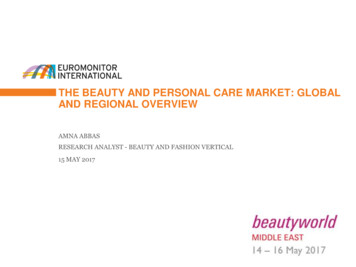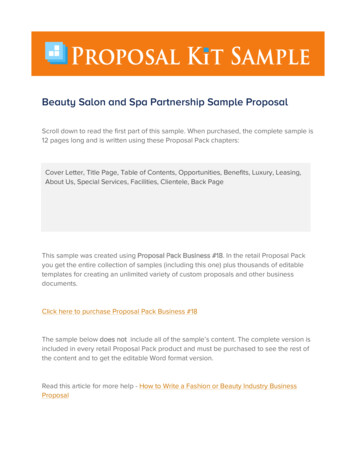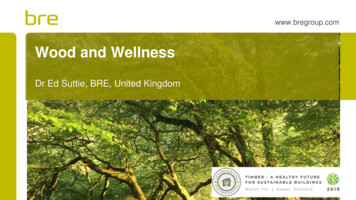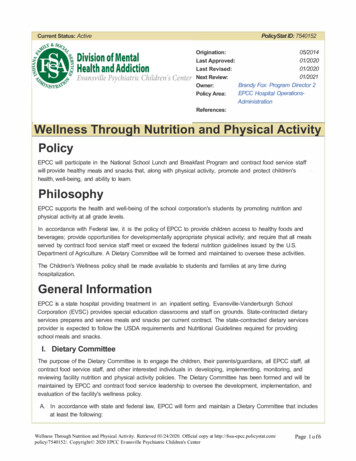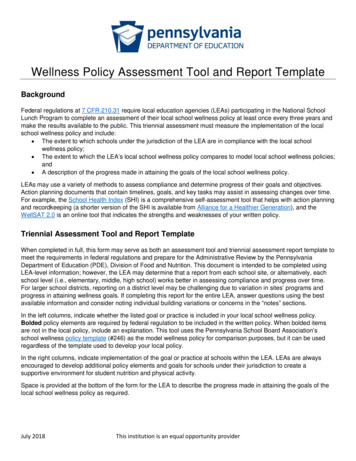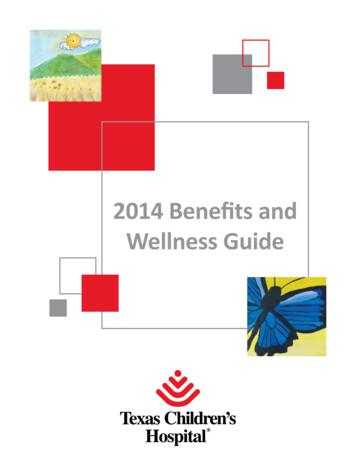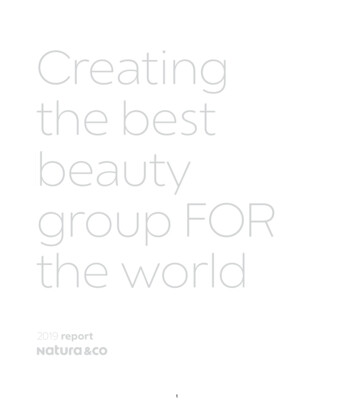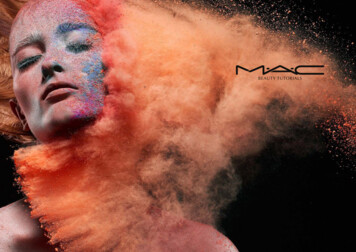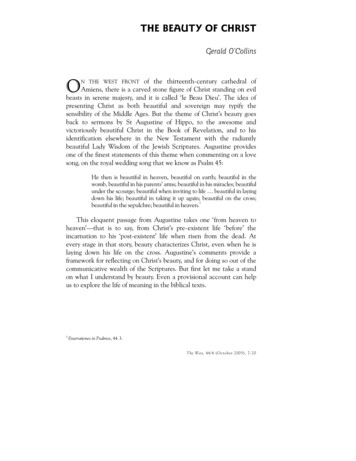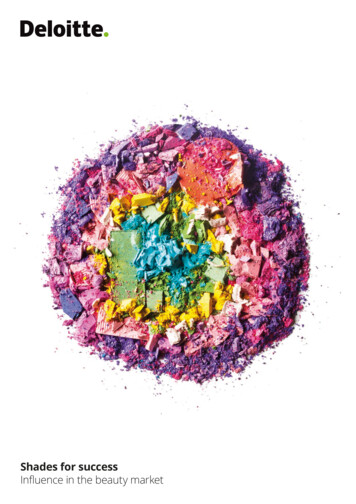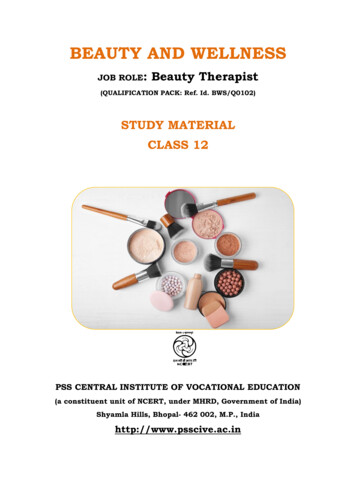
Transcription
BEAUTY AND WELLNESSJOB ROLE:Beauty Therapist(QUALIFICATION PACK: Ref. Id. BWS/Q0102)STUDY MATERIALCLASS 12PSS CENTRAL INSTITUTE OF VOCATIONAL EDUCATION(a constituent unit of NCERT, under MHRD, Government of India)Shyamla Hills, Bhopal- 462 002, M.P., Indiahttp://www.psscive.ac.in
BWS – Beauty TherapistPage 2COURSE OVERVIEWA beauty therapist is a professionally trained individual who specialises in beauty servicesof both the face and body. A beauty therapist performs various duties such as providingskin care, applying makeup, removal of unwanted hair, manicure and pedicure services.The Beauty Therapist needs to be knowledgeable on health, safety and hygiene, beautyproducts, and a range of beauty services.COURSE OUTCOMES: On completion of the course, students should be able to: Identify skin type correctly; Define skintone or undertone; State features of various makeup products; Identify various makeup products; Apply makeup products correctly; Explain the importance of colour wheel in the makeup; Define terms like hue, tint, shade, tone, complementary colours, warm colours,analogous colours and cool colours; Perform tests to identify skin tone; Describe various makeup removal methods; Explain the importance of facial steaming; List benefits of steaming; Use correct electrical brush for deep cleansing; Perform galvanic electro- facial skin treatment; Use lymphatic drainage machine; Carryout ultrasonic exfoliation; State the importance of personal grooming; State the responsibilities of a receptionist; Schedule an appointment with a client; Maintain reception area as per salon standards; State various methods of payment; Handle financial transactions effectively; and Create a positive impression at the workplace.
BWS – Beauty TherapistPage 3CONTENTSUNIT 1: MAKEUP SERVICESSESSION 1: BASIC SKIN TYPES AND SKIN TONESSESSION 2: MAKEUP PRODUCTSSESSION 3: SELECTION AND APPLICATION OF RIGHT MAKEUPPRODUCTS TO ENHANCE FACIAL FEATURESSESSION 4: THE COLOUR WHEELSESSION 5: BASIC BINDI DESIGNSSESSION 6: DRAPINGSESSION 7: MAKEUP REMOVAL METHODSUNIT 2: FACIAL BEAUTY SERVICESSESSION 1: FACIAL STEAMERSESSION 2: ELECTRO FACIAL SKIN TREATMENTUNIT 3: SALON RECEPTION DUTIESSESSION 1: CLIENT CARESESSION 2: MAINTAIN RECEPTION AREASESSION 3: PROCESS PAYMENTSUNIT 4: CREATING POSITIVE IMPRESSION AT WORK PLACESESSION 1: CREATING POSITIVE IMPRESSION AT WORK PLACEGLOSSARYFURTHER READING
BWS – Beauty TherapistPage 4Sector: Beauty &WellnessJob Role: Beauty TherapistUNIT 1: MAKEUP SERVICES
BWS – Beauty TherapistPage 5UNIT 1: MAKEUP SERVICESLEARNING OUTCOMESOn completion of this unit the student will be able to: Identify skin types accurately;Explian ‘skin tone’ and ‘undertone’;List various products required for the makeup;Select right products based on the skin type and client’s requirement;Apply foundation, concealer, face powder, blusher, highlighter,shader, eyeshadow, eyeliner and lipstick;Explian the importance of colour wheel and state its significance inthe makeup;Distinguish between primary colours, secondary colours and tertiarycolours;Perform tests to identify skin undertone;Identify some commonly used bindi designs; andUse various makeup removal methods.
BWS – Beauty TherapistPage 6INTRODUCTIONThe Beauty and Wellness Industry in India is growing at a CAGR of 18.6 % and is likely toreach the 100,000 crore mark soon. Increased emphasis on a holistic wellbeing withpeople's desire to look good and young are other motivators for the Beauty and WellnessIndustry. Employment in Beauty and Wellness sector is expected to grow at a CAGR of20%, with 23% in organised and 15% in unorganised segments with a shortage of over600,000 skilled personnel by the end of 2016. With a shift in focus towards the quality ofservice, the industry has been looking to hire a skilled workforce to sustain growth.A Beauty Therapist provides various skin care and makeup services to enhance facialfeatures using a range of products. The makeup services should suit the client'srequirement and skin type.The skin may be broadly categorised as normal skin; dry skin;sensetive skin; mature skin; oily skin and combination skin.The beauty therapist should also be aware of various types of products and most popularbrands. To achieve the desired results, the products have to be applied in a particularsequence.A makeup artist is required to suggest suitable colour based on the skintone andcomplexion. Therefore it is important to understand how the colour wheel works.This unit describes the following topics: Basic skin types and skin tonesVarious makeup productsHow to select and apply right makeup product to enhance facial featuresVarious bindi designsDraping techniquesMakeup removal methods
BWS – Beauty TherapistPage 7SESSION 1: BASIC SKIN TYPES AND SKIN TONESLEARNING OUTCOMESOn completion of this unit the student will be able to: List various types of skin;Explain features of various skin types;Identify skin type correctly; andDescribe ‘Skin tone’ and ‘Undertone’.Basic skin typesA Beauty Therapist should be aware of basic skin types to provide effective skin careservices. The following are the general types of skin: Normal skinDry skinAllergic and Sensitive skinMatured skinOily skinCombination skinNormal skinDry skin- Generally, the pH of skin ranges from 5.5to 5.8.- Very rare to find such type of skin.- It is a balance between the dry and oilyskin.- Normal skin has healthy colour and issoft.- The skin has a translucent glow.Allergic and Sensitive skin- Dry skin is due to lack of lubricationfrom the sebaceous glands.- Dry skin can be identified by the finelines around the eyes and the mouth.- Skin loses elasticity slowly with theage.- Very sensitive to cold, heat and wind.- The skin becomes allergic and sensitivebecause of broken capillaries and resultsin rashes or irritation through strongpreparation.- This type of skin is thicker and coarserthan other types of skins.- It has a tendency to develop openpores, pimples, blackheads, papulesand pustules.- Oily skin can be found around the noseand chin.- Oily skin is the result of clogging ofsebaceous glands causing sluggishcirculation.Combination skinMatured Skin- It is very similar to dry skin inappearance.- Appears parched, saggy and dehydrated.- Skin is deeply lined and loose.Oily skin- This type of skin is very common.- This can be identified by the oily centrepanel or T- zone with pores and slightoil.
BWS – Beauty TherapistPage 8Basic skin tone‘Skin tone’ also called as ‘Undertone’ describes the shade of the skin. It is different to theskin complexion. The shade of the skin may be light, medium or dark.The undertone will remain the same irrespective of the weather conditions or exposure tovarious climatic conditions.The skin tone will help in selecting the right lipstick colour and which colours are mostsuited for the makeup.
BWS – Beauty TherapistPage 9SESSION 2: MAKEUP PRODUCTSLEARNING OUTCOMESOn completion of this unit, the student will be able to: List various products required for makeup;Identify various types of foundation and explain their features;Explain the necessity for blusher, shader and highlighter;State the purpose of using mascara;List various types of eyeshadows; andIdentify various types of eyeliners and state their features.IntroductionA beauty therapist uses variousproducts to provide makeup serviceas per the client’s needs.Some of the commonly usedmakeup products are:1. Foundation2. Blusher3. Mascara4. Eyeshadow5. EyelinerIn this unit, we will study various products, their types and application.FoundationFoundation is applied to achieve smooth and even complexion. Foundation can be appliedto eye makeup, cheeks or lips. The right shaded foundation will disappear into the face.A beauty therapist is required toselect right type and brand of thefoundation so that it can go well withmakeup.
BWS – Beauty TherapistP a g e 10Types of Foundation1. Liquid (Cream) foundation2. Tinted moisturiser3. Oil based foundation4. Sheer foundation5. Matte or oil free foundation6. Mousse or whipped foundation7. Stick foundation8. Powder or compact foundation9. Shimmer foundation10. Waterproof foundation11. Foundation primerLiquid (Cream) foundationCream foundation is suitable for Normal or Dry skin. Itprovides heavy coverage. Liquid foundation is availablein many specialised versions such as oil-free, oil-based,waterproof, etc.Tinted moisturiserTinted moisturisers are used to cover up someunevenness and provide light coverage. These are bestsuited for women with pretty good skin.These are best suited for warmer months where littlecoverage and moisturising effect is required.Oil-based foundation makeupThis type of foundation is best suited for dry skin andprovides temporary ‘plump up’ skin effect. This also actsas the moisturiser.Oil- based foundation makeup can be used for olderwomen to minimise the appearance of fine lines andwrinkles.Sheer foundationThe sheer foundation is used for normal or dry skin. This provides the appearance that nofoundation is applied at all. This type of foundation provides light coverage.Many sheer foundations contain SPF 40, which is helpful in providing sun protection.“Matte” or "Oil-free" foundationThe base for such foundations is water and not oil. This is best suited for oily skin. Oil-freefoundations dry very quickly.To add additional layers, a moisturiser or foundation primer is required.
BWS – Beauty TherapistP a g e 11Mousse or Whipped foundationThis is a liquid foundation with air whipped in.Such foundations provide perfect matte finish andweightless feel.This is best suited for all types of skin.Stick foundationThe coverage is heavy and is perfect for covering upblemishes, scars, reddened areas and dark under-eyecircles.They are best suited for normal to oily skin.It is recommended to apply stick foundation only tothe problem area. Rest area can be covered by regularliquid or cream foundation.Powder ( Compact) foundationIt makes a great foundation for women who want onthe-go portability. It is a combination of powder andfoundation and available in various formulations. Thisis best suited for oily skin.Mineral foundationThis foundation is best suited for the people interestedin natural or organic makeup. Mineral foundationsconsist of natural minerals. This type of foundationcan be used on sensitive/allergic skin.Waterproof foundationThis foundation is suitable for humid areas and hotdays. It is made to stay for a long time. A makeupremover is required to remove the foundation.Foundation primerThis foundation is used to fill little cracks and pores. This facilitates application offoundation smoothly and seamlessly.BlusherBlushers are used to enhance the features of the face such as cheeks and eyes. There aredifferent forms of blushers such as powders, creams, gels, mousses, sticks and liquids. Powder blush is very popular and commonly used.Cream blush is denser and consists of natural oils and moisturisers.Gel blush is best for oily skinTint blush stays for a long time till the wish to remove the make upShimmers are really important to provide a light glow over your face
BWS – Beauty TherapistP a g e 12Types of Blush1. Powder blush2. Cream blush3. Gel or fluid blushPowder BlushCream BlushThis is good for all types of skin. Powderblusher is applied after the face powder.Powder blush can be applied effortlesslyas compared to the liquid and creamblush.Cream blush provides more strong shadowthan the powder blush. The best method toapply cream blush is by using fingers. Creamblush consists of wealth moisturising or oilcomponents. It is best suited for the dry skintypes.This should be applied over the base but beforethe powder. Cream blush is attractive forevening makeup.Gel or Fluid BlushGel blush adds the glow to the skin. This blush isbest suited for oily to the usual skin. The gelblush is of fast-drying nature and thus it is hardto disperse onto dry skin. The gel blush shouldbe applied over foundation or on the bare skin.MascaraMascara cosmetic is used to enhance the eyelashes. It is used to darken, thicken, lengthenor define the eyelashes.Types of Mascara1. Powder mascara2. Cream mascara3. Liquid mascara
BWS – Beauty TherapistP a g e 13Powder mascaraWater is added to the powder mascara. Awand is required to apply this mascara. Itgives a false kind of eyelash finish.Cream mascaraMascara provides volume to thin and sparseeyelashes and adds depth to the eyes.Liquid mascaraLiquid mascaras are most commonly used bywomen. It enhances and sharpens the lashes.EyeshadowThere are many forms of eyeshadows available in the market. These are available in variousforms such as powders, pencils, crayons, etc. Eyeshadows are made up of waxes, oils andpigments to provide the colour.Types of Eyeshadow1.2.3.4.5.6.Powder eyeshadowCream eyeshadowLiquid eyeshadowLoose powder eyeshadowCrayon eyeshadowBaked eyeshadowPowder EyeshadowCream Eyeshadow- Available in various forms; pans, tubesand sticks.- Provides shimmery and long- wearingformula.- Cream eyeshadows should be avoided inhot weathers as they will melt down.Two or more colours can be combined togive a rich look.- This is the most commonly used eyeshadow.- It is easy to blend.- Available in various kind of finishes;oMatte eyeshadowoShimmer eyeshadowoSatin eyeshadow- Never rub powder eyeshadow.- Apply by gently patting and pressing thecolour onto the eyelid .
BWS – Beauty TherapistP a g e 14Liquid Eyeshadow-Loose powder EyeshadowPerfect shadow for beginners.Apply directly onto the lids with the wandor with a fine thin liner brush.Liquid eyeshadows dry quickly.Easy to apply.-Crayon Eyeshadow-Used for advanced makeup.Not suitable for dry skin.Baked EyeshadowVery easy to use since it is slid on thelids.It can usually last up to 24 hrs.-The eyeshadow is baked in an oven.It is ultra smooth and easily bendable.EyelinerEyeliner is used to define the eye area and to help accentuate the eye and lashes.There are various forms of eyeliners available in the market.Types of Eyeliner1.2.3.4.5.6.7.Liquid eyelinerFelt-tip eyelinerGel or Cream eyelinerKohl Pencil eyelinerKajal eyelinerRegular pencil eyelinerMechanical twist–up eyeliner
BWS – Beauty TherapistP a g e 15Liquid eyeliner-There are two types of eyeliners namely,brush tip and felt-tip marker.The liquid eyeliner stays long.Gel or Cream eyeliner--Kajal eyeliner-These have an immediate benefit over thepencil eyeliners.This eyeliner is a like a dried outmarker.This eyelinerlasts muchmore than anyothereyeliners.It has waxy consistency and can beapplied with the help of a brush or a qtip.This can be used when there is arequirement of waterproof eyeliner.Kohl Pencil eyeliner-It is known for creaminess.Much easier to smudge around.It is used to create smokey eyes.
BWS – Beauty TherapistP a g e 16SESSION 3: SELECTION & APPLICATION OF MAKEUPLEARNING OUTCOMESOn completion of this unit, the student will be able to: Suggest suitable makeup based on the skin type and occasion;Select and apply right kind of foundation based on the skin type;Apply face powder/loose powder over the foundation;Use appropriate blusher/shader and highlighter;State the importance of eyeshadow and use right eyeshadow based onthe client’s requirement; andSelect and apply the right type of lipstick.IntroductionWe have studied various products used in the makeup and their features, application andsuitability. In this section, we will study the method to apply various makeup productssuch r/Shader/HighlighterEye shadowEyelinerLip PencilLipstickApplication of FoundationStep 1: Decant Foundation from the containeronto a pallet.Step 2: Match the foundation with the client’sskin tone using damp sponge or fingers.Step 3: Cover the eyelids and lips.Step 4: Apply green cover stick/concealer beforethe foundation if you have any pimples or redareas.Step 5: Squeeze out some foundation onto yourspatula and apply onto your handStep 6: If you are using your hand for applyingfoundation then apply a dot on the forehead, cheeks, nose and chin and jawline and spreadit evenly.Step 7: Take your foundation brush and blend the foundation in downwards strokingmovements. Ensure that no makeup is visible and all is blended in well.Step 8: Remove extra Foundation around the hairline and eyebrow by using a damp cottonwool pad.Step 9: If needed apply a colour wash after the Foundation. This will give glaze over theskin.
BWS – Beauty TherapistP a g e 17Application of ConcealerConcealers are used to improve or correctimperfections of the skin.Step 1: Apply concealer to the relevant areawith a cotton brush or cotton bud.Step 2: Press into the skin with a drysponge.Step 3: Apply coloured concealer only to thearea where it is required.Application of Facepowder/Loose powderPowders help to conceal and set thefoundation and prevent shine and smearingof the underlying makeup. There are specialingredients in some powders that help tocover blemishes, such as zinc oxide, theyalso tend to be heavier and a strongercompact.Step 1: Tip a small amount of loose facepowder into a bowl.Step 2: If using block powder, scrape asmall amount off with a palette knife into a bowl.Step 3: Apply with dry cotton wool; work downwards covering the eyes and all of the face.Ensure that no makeup is visible and all is blended in well.Benefits of loose translucent powder:Loose powder creates a more natural look. It sets the basis of your make-up – foundation, cover stick. It creates a more matte appearance. It blots any oiliness.Application of Blusher/Shader/HighlighterRouge also called blush or blusher, is a cosmetic typically used to redden the cheeks so asto provide a more youthful appearance and to emphasise the cheekbones.There are 2 types of blush:1. Compact blush2. Cream blush
BWS – Beauty TherapistP a g e 18Step 1: Use a spatula to remove theblusher from the container.Step 2: Apply shader or darker blusher,always start with a minimum amount andthen add to it.Step 3: Apply the blusher using a cleanbrush along the cheekbones; never take theblusher in towards the nose.Step 4: Place the brush in the middle of thearea that you are going to cover and blendback and forth.Application of EyeshadowEyeliners are categorised into three groups namely:Highlighters: Cream, white, beige colours (very light and neutral)Medium colours: Like blue, green, brown, grey, pink, etc.Eyeliner colours: Black, dark brown, grey.Matte colours: Creates a good illusion.Glittery/shiny colours: Let the illusion disappear.Step 1: Analyse the eye shape so that you know how to correctly apply the eyeshadowStep 2: Scrape the powder onto the palette.Step 3: Using eyebrow brush, brush eyebrows in an upwards direction.Step 4: Then take the brush and “drag”down any hair that may be out of theirplace.Step 5: Apply the lightest powder first.Step 6: Apply over the entire eyelid and thebrow area.Step 7: Dust loose powder under the eyeusing a tissue to prevent the shadow fallinginto the foundation.Step 8: Apply the contrasting shade, thismay be applied to the socket and blendedoutwards and upwards.As a practice darkest colour is applied in the last phase.
BWS – Beauty TherapistApplication of EyelinerEyeliner is used to define the eye area and tohelp accentuate the eye and lashes.Step 1: Cake eyeliner should be applied with afine wet brush.Step 2: Liquid eyeliner should be used with adisposable brush.Step 3: Never apply to the whole of the eyes asthis will make the eyes appear heavy and small.Application of Lip pencilStep 1: Start at the cupids bow in light strokesand follow the upper lip to the outer corners,then work from the centre on the lower lip.Step 2: Darken if necessary.Application of LipstickStep1: Firstly start off by applying foundation, a bit of coverstick and lots of powder onto your lips. This will set the base foryour makeup.Step 2: Take a lip liner pencil, similar to the lipstick colour thatyou are going to use and apply it either just inside your naturallip line if you have full lips, or just on the outside of yournatural lip line for smaller lips.Step 3: Take your lipstick colour and apply it with your lipstickbrush.Step 4: Apply some powder over this.Step 5: Repeat steps 2 and 3.P a g e 19
BWS – Beauty TherapistP a g e 20SESSION 4: THE COLOUR WHEELLEARNING OUTCOMESOn completion of this unit, the student will be able to: State the importance of colour wheel in the makeup;Distinguish between primary, secondary and tertiary colours;Define important terms like hue, tint, shade, tone, complimentarycolours, analogous colours, warm colours and cold colours;Perform vein test and old jewellery trick to understand the undertone;andList various bindi designs and suggest suitable bindi design to theclient.IntroductionA makeup artist is required to suggest clients suitable colours based on the skintone andcomplexion. Some colours may look good for a particular skin complexion.Therefore, it is important to understand how colours work. The theory of colourcombination is best understood by studying the colour wheel.In the session, we will take you through the colour wheel.Primary coloursPrimary colours are red, yellow and blue. These colours make upall of the other colours on the spectrum.Yellow Blue GreenRed Blue VoiletSecondary coloursSecondary colours can be obtained by mixing the primarycolours together.Yellow Red Orange
BWS – Beauty TherapistP a g e 21Tertiary coloursColours on either side of the secondary colours are called as tertiary colours.For example, red-violet or blue-violet, which can be obtained by adding a little more of theclosest primary colour.Terms1. HueHue can be defined as,"The degree to which a stimuluscan be described as similar to or different from stimulithat are described as red, green, blue and yellow". Hue isrepresented quantitatively by a single number. Huecorresponds to an angular position around a central orneutral point or axis on a colourspace coordinatediagram (such as a chromaticity diagram) or colourwheel, or by its dominant wavelength or that ofits complementary colour.Brightness and density of the colours can be adjusted byadding white or black or grey colour to the primary colours. By this way, we can get pasteland muted colours.2. TintThe tint is defined as the mixture of a colour withwhite. Tint increases the lightness of a colour.Lavender can be obtained by adding white tointense purple.3. ShadeShade is the mixture of a colour which reduceslightness. To obtain a deeper, richer red black isadded to the bright red.4. ToneThe‘True tone’ is the combination of any hue withthe addition of pure grey.5. Complimentary coloursThe colours that are opposite to each other onthe colour wheel are called as complimentarywheels.
BWS – Beauty TherapistP a g e 226. Analogous or similar coloursThe colours that are found right next to each other on the colour wheel are called asAnalogous colours.7. Warm coloursColours with red, orange or yellowundertones. Warm colours are brightand energetic and tend to popforward.8. Cool coloursColours with blue or red undertones.Cool colours are more soothing andtend to recede a bit more.Significance of colour wheel to makeupWe have seen that the colours are broadly classified as ‘Warm’ or ‘Cool colours’. It is to be noted herethat the undertone has a major impact on the colour scheme for the makeup.Thre are two simple ways to determine the undertone.1. Vein testObserve for the vein colours under the wrist. If the vein appears blue in colour, then theundertone is categorized under warm undertone. Warm clours should be used for makeup.If the vein appears green, then it is to be interpreted as a cool undertone. A makeup artistshould use cool colours for the makeup.2. The Old Jewellry TrickThe undertone can also be determined whether the client looks good in gold or silver. If theclient looks good in gold ornaments, then the undertone is warm. If silver ornaments aresuitable for the client, the undertone is cool.The colour wheel helps in identifying the suitable colour for the foundation, conceal, blush,eyeliner and lipstick.The basic rule is to stick to cool colours for cool undertone and warm colours for warmundertone.
BWS – Beauty TherapistP a g e 23SESSION 5: BASIC BINDI DESIGNLEARNING OUTCOMESOn completion of this unit the student will be able to: List various bindi designs and suggest suitable bindi design to theclient.IntroductionBindi is a symbol tradition and style and addscharm to overall personality. Bindis are availablein various designs, shapes, sizes and colour.1. Snake style bindiThis style will help to look wild and fashionable. It is a very popular design.2. Letter style bindiThis type of bindi adds little fun to the bindi style.
BWS – Beauty TherapistP a g e 243. Questionmark style bindiThis bindi design provides fetish, freaky look.4. Designer bindiThis bindi style goes well with designer sarees.5. Tribal style bindiThis is best suited for long skirts and tribal print tops.6. Flower style bindiThis a simple bindi design. Looks beautiful when worn with embroidered kurtis andSalwars.
BWS – Beauty TherapistP a g e 257. Party wear bindi designThis bindi style looks best when worn with black sarees, lehengas and sequins worksalwars.8. Half moon style bindi designLooks best on square, long and heart-shaped faces.9. Sun style bindi designA form of bindi style that represents the divine form of energy, the Sun.
BWS – Beauty TherapistP a g e 26SESSION 6: DRAPINGLEARNING OUTCOMESOn completion of this unit, the student will be able to: Drape saree using Nivi style; andDrape lehenga and dupatta.Draping a Saree in Nivi Style or Air hostess Style First figure out the innermost and outermost part of the Saree as well as the lowerand upper end of the Saree. Ensure that the Saree is creasefree.Step 1: Have the client put on theunderskirt (petticoat), Blouse andfootwear. Check that underskirt istightly tied and that there are nowrinkles in the front.Step 2: Tuck the innermostand upper end of the Sareeinto underskirt at the waistin the front.Step 3: Wrap the sareefrom right to left aroundthe lower body once. Keeptucking the saree at thewaist in a manner thatthere are no wrinkles in thelength of the saree.
BWS – Beauty TherapistP a g e 27Step 4: Now gather the saree into6-7 pleats of the same size whichwould be between of about 4 to 6inches in width depending on thefall of the saree.Step 7: Drape the saree oncemore, left to right around theStep 5: Check that thepleats are in order along thelength of the saree.Step 8: Take it diagonallyacross the upper body andStep 6: Tuck the topmost3-5 inches into the skirt,justbelowthenavel.Ensure that the sareereaches floor but does nottouch it.Step 9: The pallu is 3 to 5feet in length as per the
BWS – Beauty Therapisthip without tucking and bringit round to the front.P a g e 28drape over the shoulder. Therest falls freely down the backfrom the shoulder and iscalled the pallu.height and preference of theclient. Adjust the edge of the Saree at the back and front to ensure that the Edge is smoothand the folds of the pleats are straight and symmetrical and the midriff isadequately covered as per the client’s preference Most people prefer to pin up the saree as various points to maintain the symmetry ofthe folds and pleats as well as keep the saree securely in place. The saree can bepinned at the pleats tucked in front at the waist or at the shoulder where the pallubegins its fall at the back. The pleats of the pallu can also be pinned at the shoulderand sometimes a pin is used to gather the pleats in front from inside the saree. The Pallu can be left to hang down the shoulder in pleats or without pleats. It canalso be wrapped around and tucked into the waist or draped it over the rightshoulder or the edge can cover the head in a graceful manner.
BWS – Beauty TherapistP a g e 29How to drape a Lehenga Dupatta1. Tie on wrist:Make pleats on the dupatta and place the pleats on the right shoulder such that theoutmost end of the Dupatta falls off the shoulder and reaches a little below the knees.While placing the dupatta on the shoulder ensure that the open end of the uppermost pleatis facing out and the folded part in facing the neck.Secure the pleats at the shoulder with a safety pin that is fixed from inside the shirt, so thatit is not visible.Take the upper corner of the opposite end of the dupatta and fold it around the left wrist ina loop such that only the border is visible.Secure the loop around the wrist with a safety pin.Allow the lower corner to fall grace fully from the wrist.2. The Half Sari:This style is used in South India. Dupatta is wrapped around the waist.Tuck one corner of the dupatta in the waist at right side.Wrap the dupatta around the waist.Pleat the other end and secure it on the left shoulder in a such a way that the end fallsgracefully down the back and reached till below the knee.Ensure that the dupatta makes a V at back and is wrapped tightly.3. The V pallu:This is a Gujarati /Rajasthani style.Tuck one corner of the dupatta in left side of the lehengaMake pleats at the other end and secure it with a pin on the right shoulder.Let it fall till in front till the knee.Take the inner corner of dupatta falling in front and put it on your left shoulder.Make sure there is a V in front. Secure the V on top side with a pin.
BWS – Beauty TherapistP a g e 30SESSION 7: MAKEUP REMOVAL METHODSLEARNING OUTCOMESOn completion of this unit, the student will be able to: Describe various makeup removal methods; andRemove makeup using wipes, toner, micellar water, cold cream andcleansing oil.IntroductionIn this session, we will study various makeup removal techniques.Makeup Removal Techniques1. Using Wipes or Towelettes2. Using Toner3. Using Micellar Water4. Using Cold Cream5. Using Clean
A makeup artist is required to suggest suitable colour based on the skintone and complexion. Therefore it is important to understand how the colour wheel works. This unit describes the following topics: Basic skin types and skin tones Various makeup products How to select and apply right
